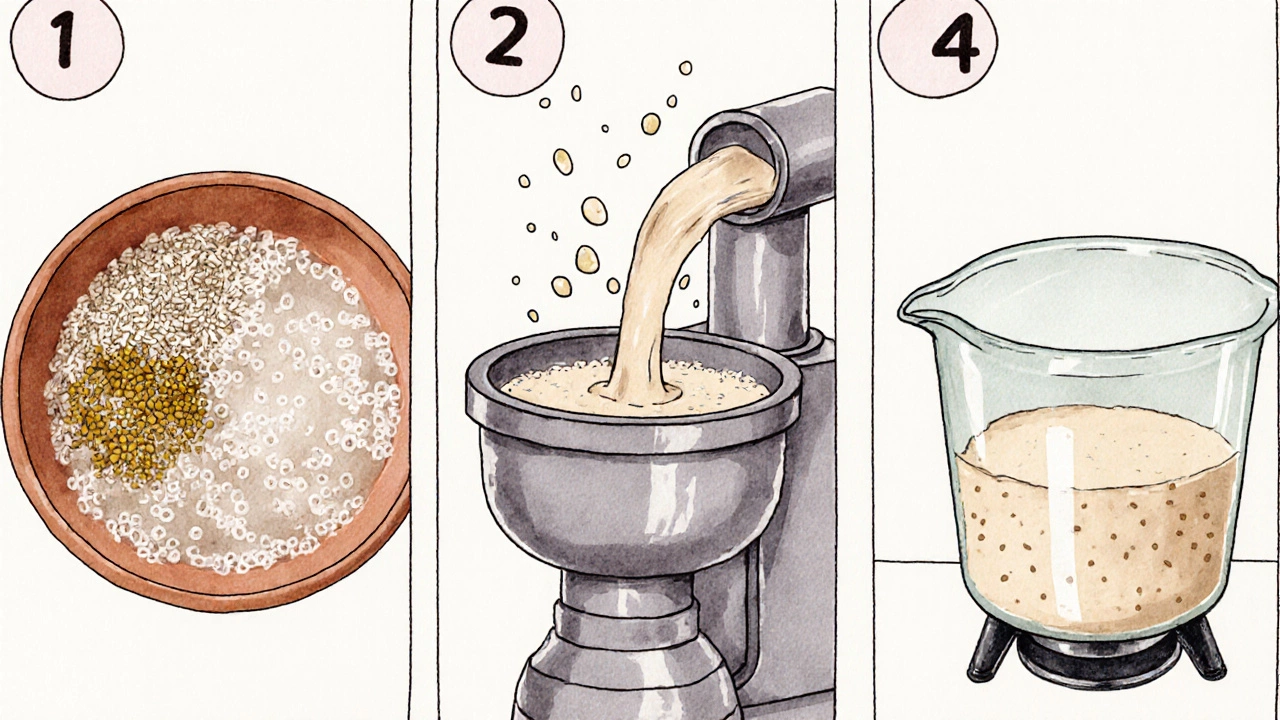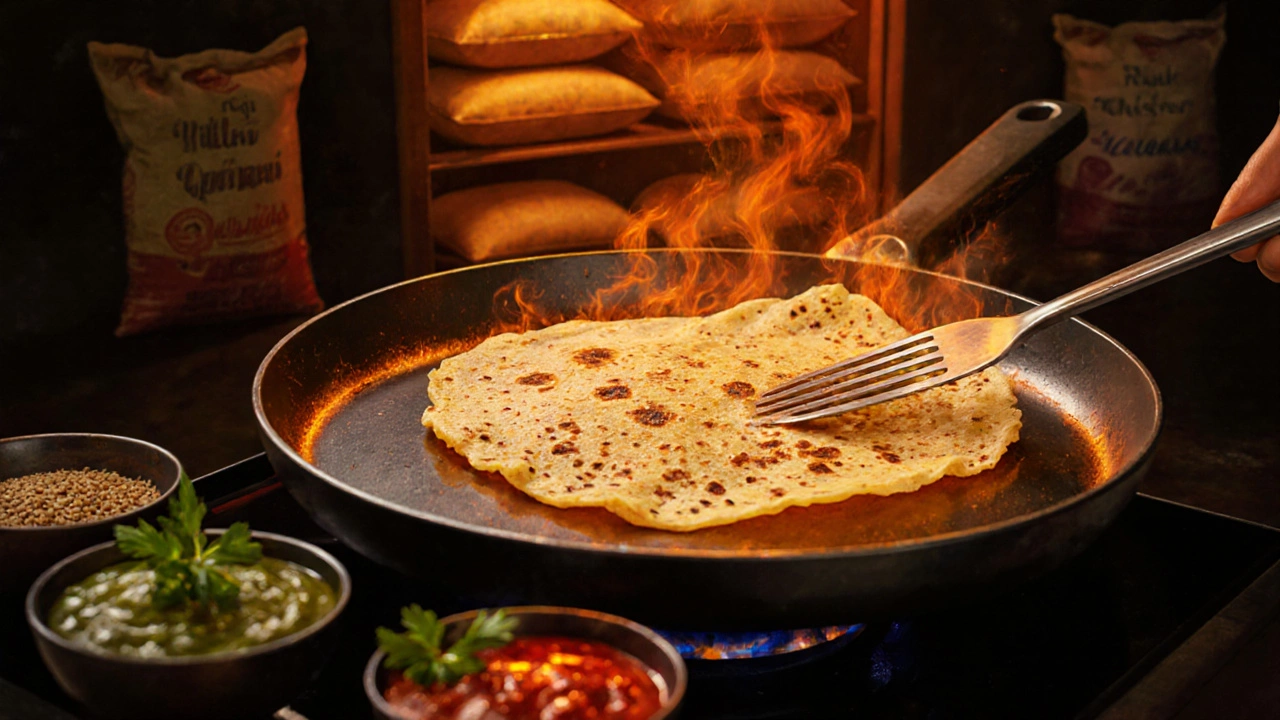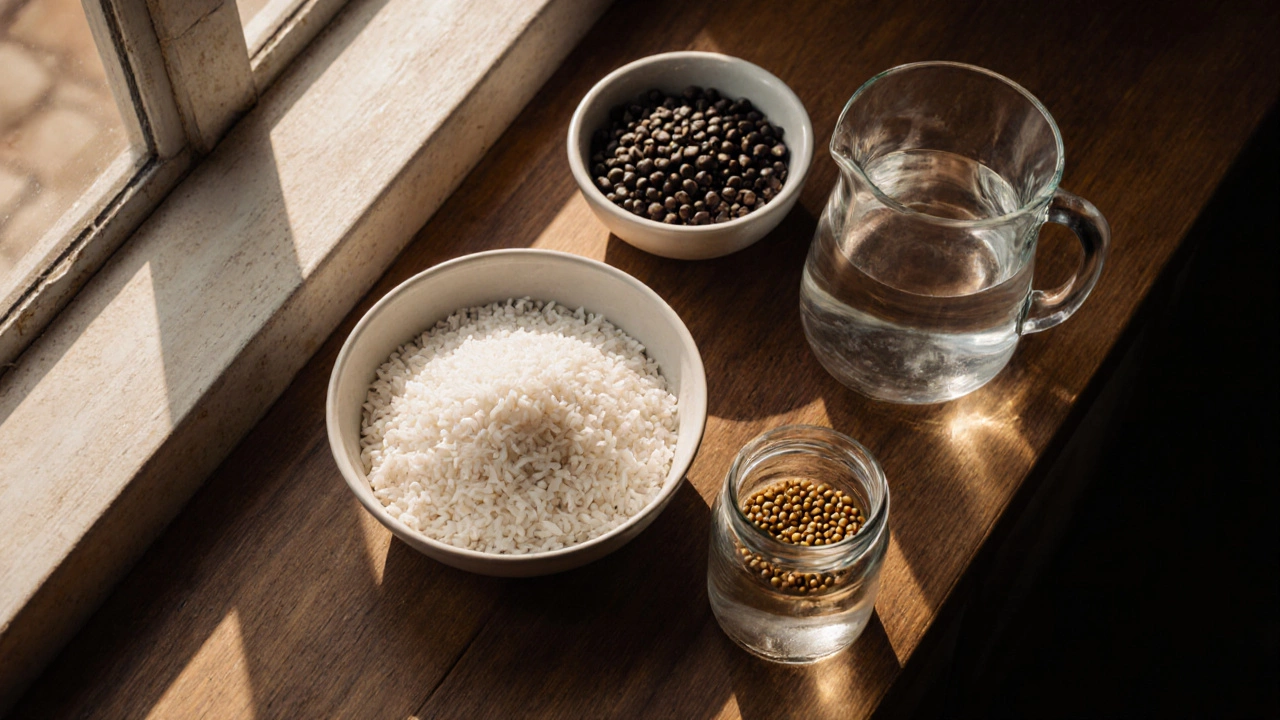Dosa Batter Calculator
Ingredients Calculator
Ever wondered what actually makes a dosa crisp and airy? The secret lies in a simple mix of grains, pulses, and a bit of patience. Below you’ll find a straight‑forward breakdown of every component that turns raw staples into the beloved South Indian batter, plus tips, swaps, and troubleshooting tricks.
What is Dosa batter?
Dosa batter is a fermented mixture of rice and lentils used to make thin, crispy crepes popular in South Indian cuisine. Once pour‑ed onto a hot griddle, the batter spreads thin, cooks quickly, and develops the characteristic lacy edges that make dosa a breakfast staple worldwide.
Core dosa batter ingredients
The classic recipe sticks to three basics:
- Parboiled rice is medium‑grain rice that’s partially boiled, allowing it to retain structure while still softening during soaking. It provides the starch needed for a light, airy texture.
- Urad dal (black gram) is a protein‑rich lentil that contributes body and fermentable sugars. It also gives the batter its subtle nuttiness.
- Fenugreek seeds are tiny aromatic seeds that aid fermentation and add a faint sweet‑bitter note. A pinch (about ½tsp per batch) works wonders.
Water is the fourth ‘ingredient’, but it’s more a medium than a flavor driver. The right water‑to‑dry‑ingredient ratio (roughly 1.5-2cups water per cup of dry mix) determines batter thickness and fermentation speed.
Why each ingredient matters
Understanding the role each component plays helps you troubleshoot later. Parboiled rice supplies fermentable starches that turn into carbon dioxide during fermentation, creating the airy pockets you see on a cooked dosa. Urad dal brings natural sugars and enzymes that feed the lactic‑acid bacteria and yeast living on the grains. Fenugreek contains a compound called diosgenin, which encourages the growth of these microbes, shortening the fermenting time and adding a faint sweetness.
Ingredient variations & alternatives
Not everyone can find parboiled rice or prefers a gluten‑free approach. Below is a quick look at common swaps, their nutrition impact, and how they affect texture.
| Base | Typical Ratio (by weight) | Flavor | Texture Impact | Key Nutrients |
|---|---|---|---|---|
| Parboiled rice | 3parts | Mild, slightly nutty | Light, crisp | Carbohydrates, some B‑vitamins |
| Ragi (finger millet) flour | 1part | Earthy, sweet | Denser, darker crust | Calcium, iron, fiber |
| Brown rice | 2parts | Nutty | Slightly coarser | Fiber, magnesium |
| Quinoa | ½part | Lightly grassy | Fluffy, less crisp | Complete protein, zinc |
| Millet blend (little, foxtail, pearl) | 1part | Neutral | Soft interior, crisp edges | Magnesium, B‑vitamins |
When using alternatives, keep the total dry‑weight the same as the traditional mix and adjust water accordingly. For a fully gluten‑free batch, replace parboiled rice with a 70%ragi + 30%millet mix.

The role of Fermentation
Fermentation is the magic step that turns raw grains into a batter that rises, smells slightly sour, and bursts with nutrients. Naturally occurring lactic‑acid bacteria (Lactobacillus) and wild yeast feed on the sugars from the rice and dal, producing carbon dioxide and organic acids.
Key factors that influence fermentation speed:
- Temperature - 30°C(86°F) is ideal; cooler rooms need 12‑16hours, hotter rooms 6‑8hours.
- Soaking time - Soak rice, dal, and fenugreek for at least 4hours (overnight is best) to hydrate and start enzyme activity.
- Cleanliness - Use a non‑metal bowl (glass or ceramic) to avoid inhibiting microbes.
When the batter has doubled in volume, smells pleasantly airy, and shows tiny bubbles on the surface, it’s ready. If you’re in a chilly Birmingham winter, place the bowl near a warm oven or use a fermenting box set to 30°C.
Practical tips for a perfect batter
- Rinse the rice and dal thoroughly (3×water) to remove excess starch that can make the batter gluey.
- Grind separately - rice first, then dal - before combining. This yields a smoother texture.
- Use a wet grinder or high‑speed blender; stop every 30seconds to scrape down the sides.
- Adjust consistency with water after grinding - batter should flow like thin pancake batter (about 2mm thickness when poured).
- Salt is added after fermentation, not before. Premature salt can stall microbial activity.
Sourcing ingredients in the UK
Most major supermarkets stock Parboiled rice in the Asian aisle. Look for brands like “Daawat” or “Mahatma”.
Urad dal is available fresh or frozen in Indian grocery stores; the frozen variety saves you a soak.
Fenugreek seeds can be bought in bulk at the same stores or online via specialty spice retailers. If you’re after gluten‑free alternatives, millet and ragi flours are sold under labels such as “Bob’s Red Mill” or “Healthy Food Co.”
For a ready‑made starter, some UK brands sell pre‑fermented dosa batter in refrigerated sections - handy for a quick weekday meal.

Common mistakes and how to fix them
- Too thick batter - Add water a tablespoon at a time; thin batter spreads better.
- Grinding not fine enough - Use a wet grinder or blend longer; a coarse grind leads to grainy texture.
- Fermentation didn’t happen - Check temperature, ensure you didn’t add salt early, and verify the bowl isn’t metal.
- Batter turned sour or mushy after a day - Refrigerate after fermentation; use within 48hours for best flavor.
Quick reference checklist
- Soak 3cups parboiled rice, 1cup urad dal, ½tsp fenugreek for at least 4hours.
- Grind rice to a smooth paste, then dal to a fluffy batter; combine.
- Add water to reach thin pouring consistency.
- Cover bowl, ferment 6‑12hours at 30°C.
- Add 1‑2tsp salt after fermentation, stir gently.
- Cook on a hot non‑stick griddle, spread thin, drizzle oil, and serve.
Frequently Asked Questions
Can I use regular white rice instead of parboiled?
Yes, you can, but the batter may turn out heavier and less crisp because regular rice releases more starch during grinding. If you opt for white rice, increase the water slightly and grind finer to counteract the density.
Do I need a wet grinder? Can a regular blender work?
A wet grinder produces the smoothest texture, but a high‑speed countertop blender works fine if you blend in short bursts, scraping the sides to avoid overheating. Adding a little water helps the blades move freely.
How long can fermented batter be stored?
In the refrigerator, a well‑fermented batter stays good for 3‑4days. The flavor will become more sour over time, which some people enjoy. For longer storage, freeze in airtight containers for up to a month; thaw overnight in the fridge before using.
Can I add other grains like quinoa or buckwheat?
Absolutely. Substitute up to 30% of the rice weight with cooked quinoa or buckwheat flour. These grains boost protein and give a unique flavor, but keep an eye on water levels as they absorb differently.
Is fenugreek really necessary?
Fenugreek speeds up fermentation and adds a subtle sweetness. If you don’t have it, you can skip it, but expect a longer fermenting time (up to an extra 4hours) and a milder flavor.
